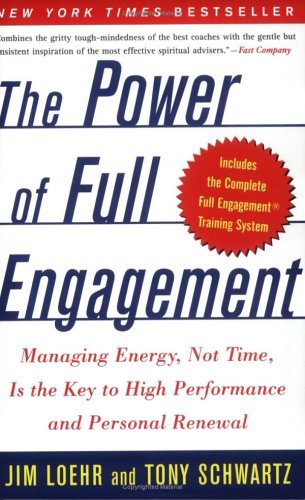
I think it might be time to take a break from reading books that start with “The Power Of…”. Seriously, I’m tired of being embarrassed when I tell people what books I’m reading! Come on, authors, a little creativity please.
The Power of Full Engagement is a self-help book by Jim Loehr and Tony Schwartz written in 1999, which makes more than a few good points about living happily and productively. It also reads a little like a 250 page advertisement for Loehr’s and Schwartz’ coaching company which they ominously refer to almost constantly, but I’m pretty sure never actually name.
The concept of the book basically distills into the idea of effort being a matter of quality, not quantity. While 250 pages seems like a lot just to say that, the case studies they give us definitely make the idea more practical.
As the tagline suggests its better to manage energy than time. We have all the time we need, but it’s useless if we’re drained and unable to make anything of it. To take a step further, the authors assert that there are different broad categories in the way energy is created and maintained in us. But all of them are fundamentally based on the balanced use and recovery of energy.
Physical Energy, they say, is the foundation of all energy. Physical activity helps to maintain a larger capacity for physical energy. If you spend every day sedentary, over time, your capacity for physical energy will diminish. Seems like a reasonable statement. If I could run 10 miles today, then sit and not do anything for a long time, I probably wouldn’t make it through the same 10 mile run a year from now. But lets be clear: not now, nor have I ever been able to run any miles. Well that’s not true, once I ran 1.7 miles, then stopped because I prefer living.
Emotional Energy is the ‘energy’ that comes from feeling good on an emotional level. Not being depressed, stressed out, or angry. This starts to feel like a stretch to the word ‘energy’, but I can roll with it. The authors point out that negative emotions are well linked with the release of stress hormones such as cortisol, which can reduce the effectiveness of the immune system. Carefully managing our emotional energy helps to ensure that we are able to say yes to the things we ought to do.
Mental Energy can basically be seen as appropriate focus and realistic optimism. “Anything that promotes appropriate focus and realistic optimism serves performance,” as they say it. The basic argument here is that trying really hard to focus all the time usually doesn’t actually lead to more focus. Again, it’s a rest and renewal thing. “Where do you have your best ideas,” is a question posed by Michael Gelb, author of How to Think Like Leonardo da Vinci. My answer was “In the shower”, which just so happens to be almost everyone’s answer. The point is, creativity–mental energy–flows more freely during mental recovery, than during mental exertion.
Spiritual Energy is the energy used and created by our values. It’s motivation. “I have time and energy right now, I should do ____.” The authors say that, “the key muscle that fuels spiritual energy is character–the courage and conviction to live by our values, even when doing so requires personal sacrifice and hardship… Spiritual energy is balancing a commitment to others with adequate self-care.” Spiritual energy becomes particularly clear during times of hardship or loss. How else could a mother continue reading to her children after her husband dies prematurely?
The second half of the book, while practical, was a little less useful and the suggestions were focused around basic things like setting goals, being honest with yourself about strengths, shortcomings and risks. I honestly felt like I could have skipped the whole section. With the exception of one really interesting point: Positive rituals.
The authors suggest that we can improve our energy levels by developing consistent positive rituals. And the reasoning makes good sense. The first time you do a crossword puzzle it uses up plenty of energy–mostly mental. But if you did the same crossword puzzle a second time the next day, it would require almost no energy. So they suggest the same is true for much of our energy usage. If we don’t have the spiritual energy to resist eating an entire cake before bedtime, making bedtime a strict ritual will remove the need to use that energy altogether. This is something I’ve found to be true in my life. Where I can ritualize something, it takes very little energy to accomplish it.
In Conclusion
The book is worth reading. It’s a welcome paradigm shift. Many of us, myself included, struggle judge ourselves as productive unless a solid 8 or 10 hours is invested every day. But measuring productivity in hours may not be useful at all. During my time reading the book, I did find myself investing a little less time in strictly work related issues. But I also found the time I have been investing to be more productive. I have been procrastinating less and feeling better about the work that’s accomplished. If you’re open to a shift in your paradigm, this is worth the 11 meaty chapters.

Recent Discussion